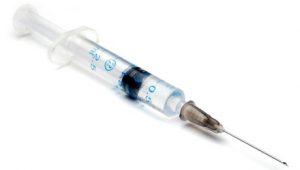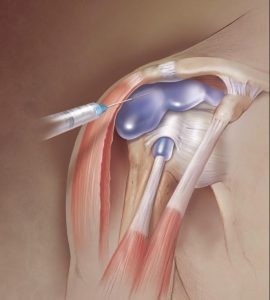Cortisone is a naturally occurring hormone that helps to regulate the body’s turnover of cells and other metabolism. It is part of the body’s response to stress. When chemically altered, it can be used as an injectable preparation to help with musculoskeletal problems, especially regional inflammation. Historically, cortisone has been used to deal with arthritic conditions of joints.

In general, there is surprisingly limited long term research on the affect of cortisone in the treatment of arthritic conditions. Most studies evaluate only short term follow-up of the patient.
Cortisone tends to have a bad reputation in the community as a substance that is painful to inject and can cause a lot of damage. My clinical experience is that the injections are typically relatively painless and do not tend to have significant long term negative effects.
The areas that I inject most in the clinic include the subacromial bursa in patients with refractory rotator cuff impingement. The area that is injected is called a subacromial or subdeltoid bursa. This is relatively easy to access from the posterolateral aspect of the shoulder joint. The types of patients I tend to inject are those who have a lot of night pain that disrupts sleep, where the shoulder throbs when they lie on either side. This can become a real burden for people suffering with rotator cuff impingement.. Also, if patients have a really distinct painful arc where there arm is very sore to lift up to the side between 60º and 120º, these patients tend to respond well to the subacromial injections.
A subacromial injection to the shoulder area is shown below.

Problems such as knee joint arthritis and hip joint arthritis are also frequently injected with cortisone. Knee joints are relatively easy to do in the clinic but hip joints are difficult to do because of the anatomy. Most patients will be referred to have the injection of the hip done under fluoroscopic guidance.
I tend to say to patients that cortisone is used for “rescue” of a really painful, swollen joint., If you have knee arthritis and your knee is really, really painful and you are getting somewhat desperate, we will do cortisone to decrease that episode. Usually, it is successful in that regard.
I tend to be stingy with cortisone in younger people and more generous with cortisone in older folks. This is due to the potential that cortisone may soften articular cartilage surfaces and this is something you do not want to do in people who are very active.
Also, cortisone should not be injected around weightbearing tendinous structures such as the Achilles or patellar tendon. A fear of rupture of these major structures is the usual rationale for avoiding injecting these areas.
